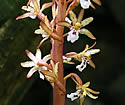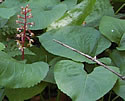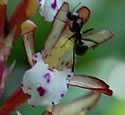Corallorhiza maculata var. occidentalis (Western Spotted Coralroot)
| Also known as: | |
|---|---|
| Genus: | Corallorhiza |
| Family: | Orchidaceae (Orchid) |
| Life cycle: | perennial |
| Origin: | native |
| Habitat: | part shade, shade; upland hardwood forest |
| Bloom season: | June - July |
| Plant height: | 6 to 21 inches |
| Wetland Indicator Status: | GP: UPL MW: FACU NCNE: FACU |
| MN county distribution (click map to enlarge): |  |
| National distribution (click map to enlarge): |  |
Pick an image for a larger view. See the glossary for icon descriptions.
Detailed Information
Flower: 

![[photo of flowers]](/udata/r9ndp23q/pd/corallorhiza-maculata-23-t.jpg) Erect raceme of 6 to 50, ½-inch flowers. Flaring at the top is a central sepal flanked by a pair of petals, with two lateral spreading sepals just below them, the sepals slightly longer than the petals. The tips, edges and outer surface are a deep reddish brown to nearly red, consistent with the color of the ovaries and stem but more yellow on the inner surface, especially towards the base. A few darker purplish spots are scattered on the surfaces. The lower lip is white with purple spotting, the larger central lobe is an inverted egg shape (obovate), widest towards the tip, with a wrinkled surface and wavy edges, curling back along sides and tip. 2 short pointed oval lance lobes are at the base. The pollen sacs hug the inside of the curved center column.
Erect raceme of 6 to 50, ½-inch flowers. Flaring at the top is a central sepal flanked by a pair of petals, with two lateral spreading sepals just below them, the sepals slightly longer than the petals. The tips, edges and outer surface are a deep reddish brown to nearly red, consistent with the color of the ovaries and stem but more yellow on the inner surface, especially towards the base. A few darker purplish spots are scattered on the surfaces. The lower lip is white with purple spotting, the larger central lobe is an inverted egg shape (obovate), widest towards the tip, with a wrinkled surface and wavy edges, curling back along sides and tip. 2 short pointed oval lance lobes are at the base. The pollen sacs hug the inside of the curved center column.
![[photo of bracts]](/udata/r9ndp23q/pd/corallorhiza-maculata-occidentalis-35-t.jpg) The large conspicuous ovary and short stalk are subtended by a short lance shaped bract up to 1/8 inch long that is often forked.
The large conspicuous ovary and short stalk are subtended by a short lance shaped bract up to 1/8 inch long that is often forked.
Leaves and stems: 

![[photo of leaves]](/udata/r9ndp23q/pd/corallorhiza-maculata-occidentalis-28-t.jpg) Leaves are reduced to several overlapping sheathes on the lower stem. Smooth throughout, leaves and stem range in color from paler brownish red to brighter reds. Stems are single to multiple clusters.
Leaves are reduced to several overlapping sheathes on the lower stem. Smooth throughout, leaves and stem range in color from paler brownish red to brighter reds. Stems are single to multiple clusters.
Fruit: 
![[photo of fruit]](/udata/r9ndp23q/pd/corallorhiza-maculata-occidentalis-3-t.jpg) Ovaries develop into hanging elliptic capsules, often pinkish yellow at maturity.
Ovaries develop into hanging elliptic capsules, often pinkish yellow at maturity.
Notes:
In Minnesota, Western Spotted Coralroot's range is limited to north central and north eastern upland forests, the more eastern portions of which is shared with the less common Spotted Coralroot (C. maculata var. maculata). While their habitats are similar enough, it is rare to find them growing in close proximity. Features that differentiate them are the lower lip and size of the small lance shaped bract at the base of each flower stalk. The lower lip of var. occidentalis is distinctly broader at the tip end than at the base, the side edges with convex ruffles that make it measurably wider (3-6 mm). The small, narrow lance-shaped bract at the flower stalk base is often discernible with the naked eye, measuring up to 3 mm long. Whether true across all populations within its range or not, in our observations of var. occidentalis in Minnesota, its colors range more from reddish brown to almost deep red, especially noted on the outer surfaces of the sepals and petals, ovary and upper stalk, where var. maculata is more yellowish throughout. The fruits also appears to be more consistently reddish pink. Also note that var. occidentalis begins flowering nearly a full month earlier, starting around June 1st, but is done by the end of July, where var. maculata starts in July and blooms for another couple weeks into August.
Native Plant Nurseries, Restoration and Landscaping Services ↓
More photos
 Western Spotted Coralroot plant
Western Spotted Coralroot plant more plants
more plants Western Spotted Coralroot habitat
Western Spotted Coralroot habitat Western Spotted Coralroot with pollinator
Western Spotted Coralroot with pollinator
Photos by K. Chayka taken at Savanna Portage State Park, Itasca County, and at Hare Lake, Lake County. Photos courtesy Peter M. Dziuk taken in Aitkin and Lake counties.
Comments
Have you seen this plant in Minnesota, or have any other comments about it?
on: 2014-08-16 14:51:22
Small cluster of stems with seed capsules growing about ten feet from the shore of Ima Lake at our campsite.
on: 2018-07-02 14:47:38
A couple of different clumps near the Pink Lady Slipper
on: 2018-11-27 17:11:19
In the vicinity of Marble Lake in a mixed forest (jack pine, spruces, aspen, paper birch). At the time they were in fruit but the plants were brilliant red.
on: 2019-06-22 09:19:09
3 nice stems of coralroot in our boreal woods right now.
on: 2020-07-15 00:00:46
Found plentifully in our campsite and throughout the campground. A long sought after find!






